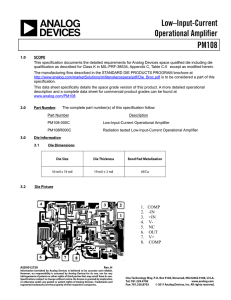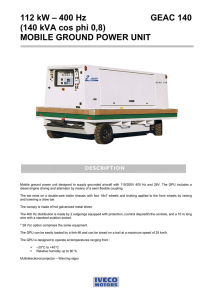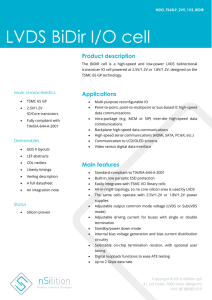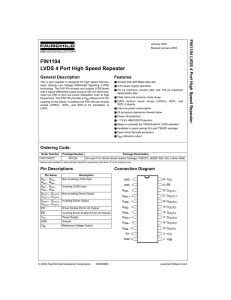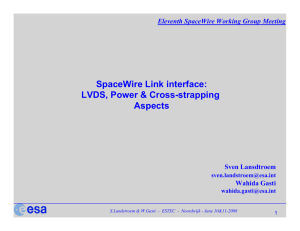DS90CP22 2X2 800 Mbps LVDS Crosspoint Switch
advertisement
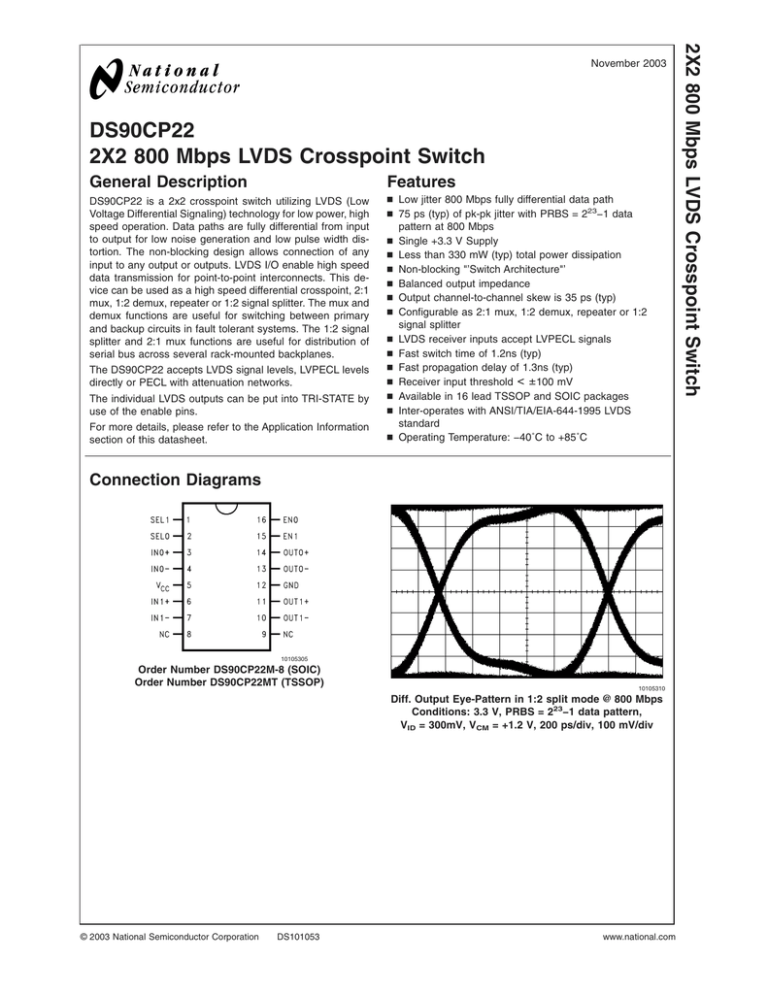
DS90CP22 2X2 800 Mbps LVDS Crosspoint Switch General Description Features DS90CP22 is a 2x2 crosspoint switch utilizing LVDS (Low Voltage Differential Signaling) technology for low power, high speed operation. Data paths are fully differential from input to output for low noise generation and low pulse width distortion. The non-blocking design allows connection of any input to any output or outputs. LVDS I/O enable high speed data transmission for point-to-point interconnects. This device can be used as a high speed differential crosspoint, 2:1 mux, 1:2 demux, repeater or 1:2 signal splitter. The mux and demux functions are useful for switching between primary and backup circuits in fault tolerant systems. The 1:2 signal splitter and 2:1 mux functions are useful for distribution of serial bus across several rack-mounted backplanes. The DS90CP22 accepts LVDS signal levels, LVPECL levels directly or PECL with attenuation networks. The individual LVDS outputs can be put into TRI-STATE by use of the enable pins. n Low jitter 800 Mbps fully differential data path n 75 ps (typ) of pk-pk jitter with PRBS = 223−1 data pattern at 800 Mbps n Single +3.3 V Supply n Less than 330 mW (typ) total power dissipation n Non-blocking "’Switch Architecture"’ n Balanced output impedance n Output channel-to-channel skew is 35 ps (typ) n Configurable as 2:1 mux, 1:2 demux, repeater or 1:2 signal splitter n LVDS receiver inputs accept LVPECL signals n Fast switch time of 1.2ns (typ) n Fast propagation delay of 1.3ns (typ) n Receiver input threshold < ± 100 mV n Available in 16 lead TSSOP and SOIC packages n Inter-operates with ANSI/TIA/EIA-644-1995 LVDS standard n Operating Temperature: −40˚C to +85˚C For more details, please refer to the Application Information section of this datasheet. Connection Diagrams 10105305 Order Number DS90CP22M-8 (SOIC) Order Number DS90CP22MT (TSSOP) 10105310 Diff. Output Eye-Pattern in 1:2 split mode @ 800 Mbps Conditions: 3.3 V, PRBS = 223−1 data pattern, VID = 300mV, VCM = +1.2 V, 200 ps/div, 100 mV/div © 2003 National Semiconductor Corporation DS101053 www.national.com 2X2 800 Mbps LVDS Crosspoint Switch November 2003 DS90CP22 Absolute Maximum Ratings Maximum Package Power Dissipation at 25˚C (Note 1) If Military/Aerospace specified devices are required, please contact the National Semiconductor Sales Office/ Distributors for availability and specifications. 16L SOIC Supply Voltage (VCC) 16L TSSOP Package Derating −0.3V to (VCC + 0.3V) 0.866 W 9.6 mW/˚C above +25˚C ESD Rating: > 5 kV > 250 V (HBM, 1.5kΩ, 100pF) LVDS Receiver Input Voltage (IN+, IN−) −0.3V to +4V LVDS Driver Output Voltage (OUT+, OUT−) −0.3V to +4V (EIAJ, 0Ω, 200pF) LVDS Output Short Circuit Current Continuous Recommended Operating Conditions Min Typ Max Units Junction Temperature +150˚C Storage Temperature Range 11.48 mW/˚C above +25˚C 16L TSSOP −0.3V to +4V CMOS/TTL Input Voltage (EN0, EN1, SEL0, SEL1) 1.435 W 16L SOIC Package Derating −65˚C to +150˚C Lead Temperature Supply Voltage (VCC) 3.0 Receiver Input Voltage Operating Free Air Temperature (Soldering, 4 sec.) 3.3 3.6 V VCC V +25 +85 ˚C 0 -40 +260˚C Electrical Characteristics Over recommended operating supply and temperature ranges unless otherwise specified Symbol Parameter Conditions Min Typ Max Units CMOS/TTL DC SPECIFICATIONS (EN0,EN1,SEL0,SEL1) VIH High Level Input Voltage 2.0 VCC V VIL Low Level Input Voltage GND 0.8 V IIH High Level Input Current VIN = 3.6V or 2.0V; VCC = 3.6V +20 µA IIL Low Level Input Current VIN = 0V or 0.8V; VCC = 3.6V ±1 ± 10 µA VCL Input Clamp Voltage ICL = −18 mA −0.8 −1.5 V +7 LVDS OUTPUT DC SPECIFICATIONS (OUT0,OUT1) VOD Differential Output Voltage RL = 75Ω 270 365 475 mV RL = 75Ω, VCC = 3.3V, TA = 25˚C 285 365 440 mV 35 mV 1.0 1.2 1.45 V 35 mV ±1 ± 10 µA ∆VOD Change in VOD between Complimentary Output States VOS Offset Voltage (Note 3) ∆VOS Change in VOS between Complimentary Output States IOZ Output TRI-STATE ® Current TRI-STATE Output, VOUT = VCC or GND IOFF Power-Off Leakage Current VCC = 0V; VOUT = 3.6V or GND ±1 ± 10 µA IOS Output Short Circuit Current VOUT+ OR VOUT− = 0V −15 −25 mA IOSB Both Outputs Short Circuit Current VOUT+ AND VOUT− = 0V −30 −50 mA 0 +100 LVDS RECEIVER DC SPECIFICATIONS (IN0,IN1) VTH Differential Input High Threshold VCM = +0.05V or +1.2V or +3.25V, VTL Differential Input Low Threshold Vcc = 3.3V −100 VCMR Common Mode Voltage Range VID = 100mV, Vcc = 3.3V 0.05 IIN Input Current VIN = +3.0V, VCC = 3.6V or 0V VIN = 0V, VCC = 3.6V or 0V 0 mV mV 3.25 V ±1 ±1 ± 10 ± 10 µA µA SUPPLY CURRENT ICCD Total Supply Current RL = 75Ω, CL = 5 pF, EN0 = EN1 = High 98 125 mA ICCZ TRI-STATE Supply Current EN0 = EN1 = Low 43 55 mA Note 1: “Absolute Maximum Ratings” are these beyond which the safety of the device cannot be guaranteed. They are not meant to imply that the device should be operated at these limits. The table of “Electrical Characteristics” provides conditions for actual device operation. Note 2: All typical are given for VCC = +3.3V and TA = +25˚C, unless otherwise stated. Note 3: VOS is defined and measured on the ATE as (VOH + VOL) / 2. www.national.com 2 Over recommended operating supply and temperature ranges unless otherwise specified (Note 4) Min Typ TSET Symbol Input to SEL Setup Time, Figures 1, 2 (Note 5) 0.7 0.5 ns THOLD Input to SEL Hold Time, Figures 1, 2 (Note 5) 1.0 0.5 ns TSWITCH SEL to Switched Output, Figures 1, 2 0.9 1.2 1.7 ns TPHZ Disable Time (Active to TRI-STATE) High to Z, Figure 3 2.1 4.0 ns TPLZ Disable Time (Active to TRI-STATE) Low to Z, Figure 3 3.0 4.5 ns TPZH Enable Time (TRI-STATE to Active) Z to High, Figure 3 25.5 55.0 ns TPZL Enable Time (TRI-STATE to Active) Z to Low, Figure 3 25.5 55.0 ns TLHT Output Low-to-High Transition Time, 20% to 80%, Figure 5 290 400 580 ps THLT Output High-to-Low Transition Time, 80% to 20%, Figure 5 290 TJIT LVDS Data Path Peak to Peak Jitter, (Note 6) TPLHD Parameter Units 400 580 ps 40 90 ps VID = 300mV; PRBS=223-1 data pattern; VCM = 1.2V at 800Mbps 75 190 ps 0.9 1.3 1.6 ns 1.0 1.3 1.5 ns 0.9 1.3 1.6 ns 1.0 1.3 1.5 ns VCC = 3.3V, TA = 25˚C Propagation High to Low Delay, Figure 6 Propagation High to Low Delay, Figure 6 Max VID = 300mV; 50% Duty Cycle; VCM = 1.2V at 800Mbps Propagation Low to High Delay, Figure 6 Propagation Low to High Delay, Figure 6 TPHLD Conditions VCC = 3.3V, TA = 25˚C TSKEW Pulse Skew |TPLHD - TPHLD| 0 225 ps TCCS Output Channel-to-Channel Skew, Figure 7 35 80 ps Note 4: The parameters are guaranteed by design. The limits are based on statistical analysis of the device performance over PVT (process, voltage and temperature) range. Note 5: TSET and THOLD time specify that data must be in a stable state before and after the SEL transition. Note 6: The parameters are guaranteed by design. The limits are based on statistical analysis of the device performance over PVT range with the following equipment test setup: HP70004A (display mainframe) with HP70841B (pattern generator), 5 feet of RG-142 cable with DUT test board and HP83480A (digital scope mainframe) with HP83483A (20GHz scope module). 3 www.national.com DS90CP22 AC Electrical Characteristics DS90CP22 AC Timing Diagrams 10105302 FIGURE 1. Input-to-Select rising edge setup and hold times and mux switch time 10105303 FIGURE 2. Input-to-Select falling edge setup and hold times and mux switch time 10105304 FIGURE 3. Output active to TRI-STATE and TRI-STATE to active output time www.national.com 4 DS90CP22 AC Timing Diagrams (Continued) 10105306 FIGURE 4. LVDS Output Load 10105309 FIGURE 5. LVDS Output Transition Time 10105307 FIGURE 6. Propagation Delay Low-to-High and High-to-Low 10105308 FIGURE 7. Output Channel-to-Channel Skew in 1:2 splitter mode 5 www.national.com DS90CP22 DS90CP22 Pin Description Pin Name # of Pin Input/Output Description IN+ 2 I Non-inverting LVDS input IN - 2 I Inverting LVDS input OUT+ 2 O Non-inverting LVDS Output OUT - 2 O Inverting LVDS Output EN 2 I A logic low on the Enable puts the LVDS output into TRI-STATE and reduces the supply current SEL 2 I 2:1 mux input select GND 1 P Ground VCC 1 P NC 2 Power Supply No Connect PCB LAYOUT AND POWER SYSTEM BYPASS Circuit board layout and stack-up for the DS90CP22 should be designed to provide noise-free power to the device. Good layout practice also will separate high frequency or high level inputs and outputs to minimize unwanted stray noise pickup, feedback and interference. Power system performance may be greatly improved by using thin dielectrics (4 to 10 mils) for power/ground sandwiches. This increases the intrinsic capacitance of the PCB power system which improves power supply filtering, especially at high frequencies, and makes the value and placement of external bypass capacitors less critical. External bypass capacitors should include both RF ceramic and tantalum electrolytic types. RF capacitors may use values in the range 0.01 µF to 0.1 µF. It is recommended practice to use two vias at each power pin of the DS90CP22 as well as all RF bypass capacitor terminals. Dual vias reduce the interconnect inductance by up to half, thereby reducing interconnect inductance and extending the effective frequency range of the bypass components. Application Information MODES OF OPERATION The DS90CP22 provides three modes of operation. In the 1:2 splitter mode, the two outputs are copies of the same single input. This is useful for distribution / fan-out applications. In the repeater mode, the device operates as a 2 channel LVDS buffer. Repeating the signal restores the LVDS amplitude, allowing it to drive another media segment. This allows for isolation of segments or long distance applications. The switch mode provides a crosspoint function. This can be used in a system when primary and redundant paths are supported in fault tolerant applications. INPUT FAIL-SAFE The receiver inputs of the DS90CP22 do not have internal fail-safe biasing. For point-to-point and multidrop applications with a single source, fail-safe biasing may not be required. When the driver is off, the link is in-active. If failsafe biasing is required, this can be accomplished with external high value resistors. The IN+ should be pull to Vcc with 10kΩ and the IN− should be pull to Gnd with 10kΩ. This provides a slight positive differential bias, and sets a known HIGH state on the link with a minimum amount of distortion. The outer layers of the PCB may be flooded with additional ground plane. These planes will improve shielding and isolation as well as increase the intrinsic capacitance of the power supply plane system. Naturally, to be effective, these planes must be tied to the ground supply plane at frequent intervals with vias. Frequent via placement also improves signal integrity on signal transmission lines by providing short paths for image currents which reduces signal distortion. There are more common practices which should be followed when designing PCBs for LVDS signaling. Please see Application Note: AN-1108 for additional information. UNUSED LVDS INPUTS Unused LVDS Receiver inputs should be tied off to prevent the high-speed sensitive input stage from picking up noise signals. The open input to IN+ should be pull to Vcc with 10kΩ and the open input to IN− should be pull to Gnd with 10kΩ. COMPATIBILITY WITH LVDS STANDARD The DS90CP22 is compatible with LVDS and Bus LVDS Interface devices. It is enhanced over standard LVDS drivers in that it is able to driver lower impedance loads with standard LVDS levels. Standard LVDS drivers provide 330mV differential output with a 100Ω load. The DS90CP22 provides 365mV with a 75Ω load or 400mV with 100Ω loads. This extra drive capability is useful in certain multidrop applications. In backplane multidrop configurations, with closely spaced loads, the effective differential impedance of the line is reduced. If the mainline has been designed for 100Ω differential impedance, the loading effects may reduce this to the 70Ω range depending upon spacing and capacitance load. Terminating the line with a 75Ω load is a better match than with 100Ω and reflections are reduced. UNUSED CONTROL INPUTS The SEL and EN control input pins have internal pull down devices. Unused pins may be tied off or left as no-connect (if a LOW state is desired). EXPANDING THE NUMBER OF OUTPUT PORTS To expand the number of output ports, more than one DS90CP22 can be used. Total propagation delay through the devices should be considered to determine the maximum expansion. For example, if 2 X 4 is desired, than three of the DS90CP22 are required. A minimum of two device propagation delays (2 x 1.3ns = 2.6ns (typ)) can be achieved. For a 2 X 8, a total of 7 devices must be used with propagation delay of 3 x 1.3ns = 3.9ns (typ). The power consumption will increase proportional to the number of devices used. www.national.com 6 DS90CP22 Block Diagram 10105301 Function Table SEL0 SEL1 OUT0 OUT1 Mode 0 0 IN0 IN0 1:2 splitter 0 1 IN0 IN1 repeater 1 0 IN1 IN0 switch 1 1 IN1 IN1 1:2 splitter Note: 0 = low, 1 = high EN0 = EN1 = 1 for enable Typical Performance Characteristics Diff. Output Voltage (VOD) vs. Resistive Load (RT) 10105311 7 www.national.com DS90CP22 Typical Performance Characteristics (Continued) Peak-to-Peak Output Jitter at VCM = +0.4V vs. VID 10105312 Peak-to-Peak Output Jitter at VCM = +1.2V vs. VID 10105313 Peak-to-Peak Output Jitter at VCM = +1.6V vs. VID 10105314 www.national.com 8 DS90CP22 Physical Dimensions inches (millimeters) unless otherwise noted Order Number DS90CP22M-8 See NS Package Number M16A 16-Lead (4.4mm Wide) Molded Thin Shrink Small Outline Package, JEDEC Order Number DS90CP22MT Order Number DS90CP22MTX (Tape and Reel) See NS Package Number MTC16 9 www.national.com 2X2 800 Mbps LVDS Crosspoint Switch Notes LIFE SUPPORT POLICY NATIONAL’S PRODUCTS ARE NOT AUTHORIZED FOR USE AS CRITICAL COMPONENTS IN LIFE SUPPORT DEVICES OR SYSTEMS WITHOUT THE EXPRESS WRITTEN APPROVAL OF THE PRESIDENT AND GENERAL COUNSEL OF NATIONAL SEMICONDUCTOR CORPORATION. As used herein: 1. Life support devices or systems are devices or systems which, (a) are intended for surgical implant into the body, or (b) support or sustain life, and whose failure to perform when properly used in accordance with instructions for use provided in the labeling, can be reasonably expected to result in a significant injury to the user. 2. A critical component is any component of a life support device or system whose failure to perform can be reasonably expected to cause the failure of the life support device or system, or to affect its safety or effectiveness. BANNED SUBSTANCE COMPLIANCE National Semiconductor certifies that the products and packing materials meet the provisions of the Customer Products Stewardship Specification (CSP-9-111C2) and the Banned Substances and Materials of Interest Specification (CSP-9-111S2) and contain no ‘‘Banned Substances’’ as defined in CSP-9-111S2. National Semiconductor Americas Customer Support Center Email: new.feedback@nsc.com Tel: 1-800-272-9959 www.national.com National Semiconductor Europe Customer Support Center Fax: +49 (0) 180-530 85 86 Email: europe.support@nsc.com Deutsch Tel: +49 (0) 69 9508 6208 English Tel: +44 (0) 870 24 0 2171 Français Tel: +33 (0) 1 41 91 8790 National Semiconductor Asia Pacific Customer Support Center Email: ap.support@nsc.com National Semiconductor Japan Customer Support Center Fax: 81-3-5639-7507 Email: jpn.feedback@nsc.com Tel: 81-3-5639-7560 National does not assume any responsibility for use of any circuitry described, no circuit patent licenses are implied and National reserves the right at any time without notice to change said circuitry and specifications.

